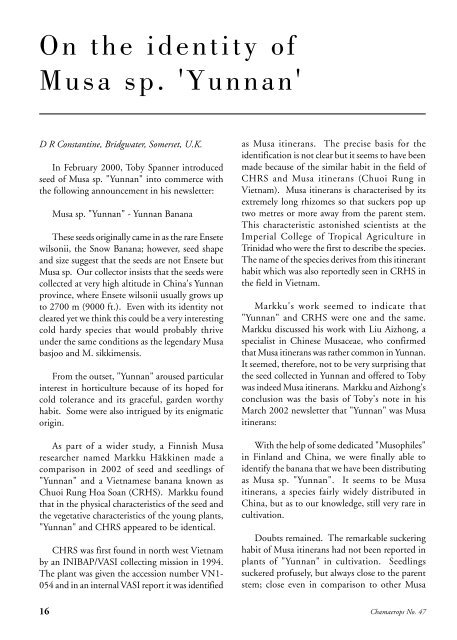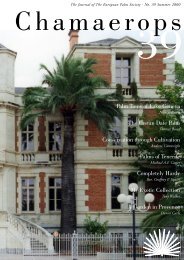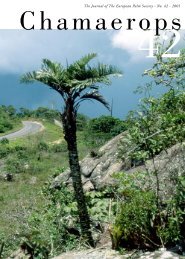O n t h e i d e n t i t y o fM u s a s p . ' Y u n n a n 'D R Constantine, Bridgwater, Somerset, U.K.In February 2000, Toby Spanner introducedseed of Musa sp. "Yunnan" into commerce withthe following announcement in his newsletter:Musa sp. "Yunnan" - Yunnan Banana<strong>The</strong>se seeds originally came in as the rare Ensetewilsonii, the Snow Banana; however, seed shapeand size suggest that the seeds are not Ensete butMusa sp. Our collector insists that the seeds werecollected at very high altitude in China's Yunnanprovince, where Ensete wilsonii usually grows upto 2700 m (9000 ft.). Even with its identity notcleared yet we think this could be a very interestingcold hardy species that would probably thriveunder the same conditions as the legendary Musabasjoo and M. sikkimensis.From the outset, "Yunnan" aroused particularinterest in horticulture because of its hoped forcold tolerance and its graceful, garden worthyhabit. Some were also intrigued by its enigmaticorigin.As part of a wider study, a Finnish Musaresearcher named Markku Häkkinen made acomparison in 2002 of seed and seedlings of"Yunnan" and a Vietnamese banana known asChuoi Rung Hoa Soan (CRHS). Markku foundthat in the physical characteristics of the seed andthe vegetative characteristics of the young plants,"Yunnan" and CHRS appeared to be identical.CHRS was first found in north west Vietnamby an INIBAP/VASI collecting mission in 1994.<strong>The</strong> plant was given the accession number VN1-054 and in an internal VASI report it was identifiedas Musa itinerans. <strong>The</strong> precise basis for theidentification is not clear but it seems to have beenmade because of the similar habit in the field ofCHRS and Musa itinerans (Chuoi Rung inVietnam). Musa itinerans is characterised by itsextremely long rhizomes so that suckers pop uptwo metres or more away from the parent stem.This characteristic astonished scientists at theImperial College of Tropical Agriculture inTrinidad who were the first to describe the species.<strong>The</strong> name of the species derives from this itineranthabit which was also reportedly seen in CRHS inthe field in Vietnam.Markku's work seemed to indicate that"Yunnan" and CRHS were one and the same.Markku discussed his work with Liu Aizhong, aspecialist in Chinese Musaceae, who confirmedthat Musa itinerans was rather common in Yunnan.It seemed, therefore, not to be very surprising thatthe seed collected in Yunnan and offered to Tobywas indeed Musa itinerans. Markku and Aizhong'sconclusion was the basis of Toby's note in hisMarch 2002 newsletter that "Yunnan" was Musaitinerans:With the help of some dedicated "Musophiles"in Finland and China, we were finally able toidentify the banana that we have been distributingas Musa sp. "Yunnan". It seems to be Musaitinerans, a species fairly widely distributed inChina, but as to our knowledge, still very rare incultivation.Doubts remained. <strong>The</strong> remarkable suckeringhabit of Musa itinerans had not been reported inplants of "Yunnan" in cultivation. Seedlingssuckered profusely, but always close to the parentstem; close even in comparison to other Musa16 Chamaerops No. 47
species. <strong>The</strong>re were other vegetative dissimilaritiesnoted between "Yunnan" in cultivation and thetype description of Musa itinerans in the botanicalliterature. For example, "Yunnan" is a rather waxyplant whereas the leaf sheaths and petioles of Musaitinerans are devoid of wax. <strong>The</strong> leaf apex of Musaitinerans is truncate and the base rounded whereasthe leaf apex of "Yunnan" is somewhat acute andthe base distinctly auriculate. Musa itinerans hasthe robust vegetative habit and stature of acultivated banana, whereas "Yunnan" has a ratherslender, graceful habit.<strong>The</strong> type description of Musa itinerans wasbased on plants growing in the open ground inTrinidad from Burmese seed, whereas the featuresof "Yunnan" mentioned here were from plantsgrowing under glass in Europe from Chinese seed.<strong>The</strong>se vegetative differences could simply representa spectrum of types within Musa itinerans.Further, there was no information from <strong>European</strong>plants on inflorescence characteristics that arecritical in diagnosing a species. Despite theseshortcomings, the apparent differences invegetative characteristics were nonethelessintriguing, and discussion continued. In April2002, in an exchange of E-mails on this subjectwith Markku and Aizhong, Markku providedpictures of the male bud of CRHS taken inVietnam during the INIBAP/VASI mission. Itthus became possible to compare the male bud ofCRHS with that of Musa itinerans. <strong>The</strong>y wereimmediately seen to be completely different.Musa itinerans has a rather plain, convolutemale bud whereas CRHS has an extraordinary,colourful and very distinctly imbricate male bud.In one published report, the INIBAP/VASImission described the inflorescence of CRHS ashaving "bright yellow bracts with distinctive driedup tips arranged spirally on the markedly imbricatemale bud".From the photographic evidence, it seemedobvious that "Yunnan"/CRHS could not be Musaitinerans. Rather, it seemed clear that "Yunnan"/CRHS, was a hitherto unrecognised, new Musaspecies.<strong>The</strong> discovery of a new Musa in Vietnam(CRHS) would not be very surprising as much ofthat country is biologically, let alone botanically,little explored. However, the discovery of a newMusa in China ("Yunnan") and in highly botanisedYunnan of all places would be very surprisingindeed. Liu Aizhong knows more about Chinesebananas than anyone, from the field as well as theherbarium, and has done much to clarify thetremendous confusion in the Chinese literature onMusa. Yet, Aizhong did not recognise CRHS atall, and neither did another great authority on thebananas, George Argent of RBG Edinburgh.<strong>The</strong> evidence suggested that "Yunnan"/CRHScould not be Musa itinerans. <strong>The</strong>n, in August2002, Eric Schmidt published photographs of"Yunnan" flowering in cultivation for the first timeat the Harry P. Leu Gardens in Orlando, Florida.This turned the story on its head.Eric published two photographs of theinflorescence of "Yunnan" on the Zingiberdiscussion group Internet site. Eric's photographsclearly showed that the inflorescence of "Yunnan"resembled Musa itinerans and not CRHS. Despitethe fact that the Leu Gardens plants do not showthe long suckers but form "a tight clump with veryslender stalks", it seemed that "Yunnan" was Musaitinerans after all!<strong>The</strong> identification of "Yunnan" as Musaitinerans seems to be correct, although we are stillleft with some questions. "Yunnan" and CRHScannot be the same species, however similar theseed and young plants appeared to be in Markku'sstudy. Was Markku supplied with seed of Musaitinerans in the first place and not CRHS? It seemsclear that the determination of CRHS as Musaitinerans in the internal VASI report is wrong. Sowhat is CRHS? It really does seem to be a new,hitherto unrecognised species. What is thesignificance of the discrepancies in the vegetativecharacteristics of "Yunnan" and the typedescription of Musa itinerans? It may be significantthat the type was described from a very limitedsampling of the species from Burma rather thanChamaerops No. 4717










